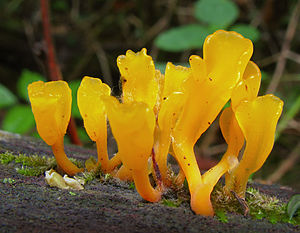Gelatinous tears
| Gelatinous tears | ||||||||||||
|---|---|---|---|---|---|---|---|---|---|---|---|---|

Dacryopinax spathularia |
||||||||||||
| Systematics | ||||||||||||
|
||||||||||||
| Scientific name of the class | ||||||||||||
| Dacrymycetes | ||||||||||||
| Doweld | ||||||||||||
| Scientific name of the order | ||||||||||||
| Dacrymycetales | ||||||||||||
| Henn. | ||||||||||||
| Scientific name of the family | ||||||||||||
| Dacrymycetaceae | ||||||||||||
| J. Schröt. |
The gelatinous tears (Dacrymycetaceae) are the only family of the order of the gelatinous tears (Dacrymycetales) and these are the only ones of the class Dacrymycetes . They include mushrooms with predominantly strikingly colored, gelatinous fruit bodies. The most famous representatives include the gelatinous tears and horns .
features

The fruiting bodies of the tear fungus are soft, gelatinous, pliable and varied. The spectrum of shapes ranges from simple knobs to stem-cup-shaped and spatula-shaped to coral-like structures. They often have bright yellow to orange colors due to carotenoids , but can also be pale or colorless. Microscopically they are characterized by Y-shaped basidia and often septate spores when ripe . Several species form secondary spores on the basidiospores.
Systematics
The family includes just under a dozen genera worldwide.
- Genus Arrhytidia
- Genus Hörnlinge - Calocera
- Genus Cerinomyces
- Genus Cerinosterus
- Genus Gelatinous Tears - Dacrymyces
- Genus Dacryonaema
- Genus Dacryopinax
- Genus Dacryoscyphus
- Genus Ditiola
- Genus Guepiniopsis
- Genus heterotextus
Individual evidence
- ↑ David S. Hibbett, Manfred Binder, Joseph F. Bischoff, Meredith Blackwell, Paul F. Cannon, Ove E. Eriksson, Sabine Huhndorf, Timothy James, Paul M. Kirk, Robert Lücking, H. Thorsten Lumbsch, François Lutzoni, P Brandon Matheny, David J. McLaughlin, Martha J. Powell, Scott Redhead, Conrad L. Schoch, Joseph W. Spatafora, Joost A. Stalpers, Rytas Vilgalys, M. Catherine Aime, André Aptroot, Robert Bauer, Dominik Begerow, Gerald L. Benny, Lisa A. Castlebury, Pedro W. Crous, Yu-Cheng Dai, Walter Gams, David M. Geiser, Gareth W. Griffith, Cécile Gueidan, David L. Hawksworth, Geir Hestmark, Kentaro Hosaka, Richard A. Humber , Kevin D. Hyde, Joseph E. Ironside, Urmas Kõljalg, Cletus P. Kurtzman, Karl-Henrik Larsson, Robert Lichtwardt, Joyce Longcore, Jolanta Miądlikowsk, Andrew Miller, Jean-Marc Moncalvo, Sharon Mozley-Standridge, Franz Oberwinkler, Erast Parmasto, Valérie Reeb, Jack D. Rogers, Claude Roux, Leif Ryvarden, José Paulo Sampaio, Arthur Schüßler, Junta Sugiyama, R. Greg Thorn, Leif Tibell, Wendy A. Untereiner, Christopher Walker, Zheng Wang, Alex Weir, Michael Weiß, Merlin M. White, Katarina Wink, Yi-Jian Yao, Ning Zhang: A higher-level phylogenetic classification of the Fungi . In: Mycological Research . tape 111 (5) . British Mycological Society, 2007, p. 509-547 , doi : 10.1016 / j.mycres.2007.03.004 ( PDF; 1.01 MB ( memento of November 22, 2010 in the Internet Archive )). A higher-level phylogenetic classification of the Fungi ( Memento of the original from November 22, 2010 in the Internet Archive ) Info: The archive link was automatically inserted and not yet checked. Please check the original and archive link according to the instructions and then remove this notice.
- ↑ K. Wells, RJ Bandoni: Heterobasidiomycetes . In: DJ McLaughlin, EJ McLaughlin, P. Lemke (eds.): The Mycota . VII. Part B. Systematics and Evolution. Springer, Berlin 2001, p. 85-120 .
- ↑ German Josef Krieglsteiner (Ed.): Die Großpilze Baden-Württemberg . Volume 1: General Part. Stand mushrooms: jelly, bark, prick and pore mushrooms. Ulmer, Stuttgart 2000, ISBN 3-8001-3528-0 .
- ↑ Dacrymycetaceae. In: Encyclopedia of Life. Retrieved July 27, 2012 .